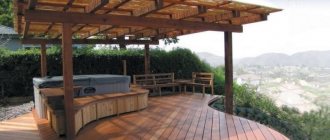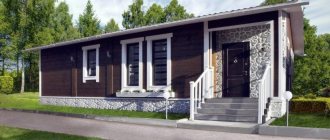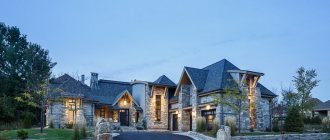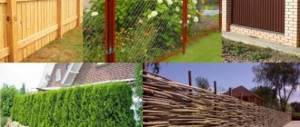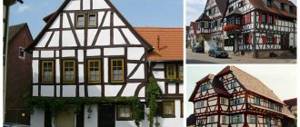Many owners of private houses are interested in issues related to the local area.
Does it need to be looked after, how and what can it be used for, and where are its boundaries?
How many meters of local area in the private sector? Let's look at all this below.
Dear readers! Our articles talk about typical ways to resolve legal issues, but each case is unique.
If you want to find out how to solve your particular problem, please use the online consultant form on the right or call. It's fast and free!
Basic Concepts
The adjacent territory is a plot of land that borders a building and is used by the owner of the building to meet his needs.
In the legislation of the Russian Federation there is no precise definition of the local area of a private house. Usually it refers to a part of the land near the yard of the house owner, which he needs to maintain his plot.
Mostly, owners of private houses completely enclose their property with a fence. It is a mistake to believe that the territory behind the fence has no owner. This land belongs to the municipality. In order to obtain the right to use this land in their own interests or dispose of it, the owner of a private house must justify his easement.
All legal issues are regulated by the Constitution of the Russian Federation, the Civil Code, the Land Code, the Law “On the State Real Estate Cadastre”, cadastral and technical documents for land.
Procedure for marking boundaries
To determine the clear boundaries of the local area of a private house, first of all, look at the cadastral passport of the land plot. After privatization, it must indicate not only the boundaries of the private property itself, but also the adjacent area that belongs to it.
For residents of the private sector, there is no exact number of meters that the local area can occupy. In each specific case, the size of the local area of a private house may differ. To determine the boundaries of the territory that applies specifically to your private home, you need to consider the following points:
- draw a plan diagram of the site and indicate on it all the objects necessary for the use of a private house.
- Mark on your plan diagram the municipal part of the land that is adjacent to your property.
- Coordinate all controversial issues with the owners of neighboring plots claiming to use this territory.
- Provide documents to the Authorized State Bodies to establish the rights to use and own the local area.
Next we will talk about what can be considered a local area, how many meters from a private house?
Standards and regulations for the local area of a private house - how many meters from the house?
The legislation of the Russian Federation does not provide for any specific standards and norms that are the same for all homeowners. Each region has the right to independently determine for itself the basic standards in force for the local area.
How many meters from the house is considered the local area of a private house? In most cases, the local area of a private house occupies approximately 1.5 - 2 meters from the fence.
Let's consider the main responsibilities of private homeowners in relation to the land behind their fence. Regardless of whether you are the owner or tenant of such territory or not, municipal authorities assign the following responsibilities to you:
There are many options for using the local area: you can organize a beautiful lawn, arrange a convenient entrance for a car, or install a swing for children. However, there are some restrictions on the use of such a site. The municipality prohibits:
- install poles, signs, fences and other structures without permission;
- burn garbage;
- litter with building materials and other items.
Legislative regulation
The use of the local area of private buildings should be based on the same regulations that apply to land located next to high-rise buildings.
These acts include :
- LCD, which contains information about the definition of the local area, and also includes the basic principles on which it can be used;
- The Land Code describes the rules for determining the size of the plot;
- The Federal Law “On Land Management” allows you to determine how land surveying is carried out correctly;
- The Tax Code provides information on how to correctly calculate the amount of tax for land that is owned by the owner of the house;
- Federal Law No. 214 indicates how to correctly distribute rights in relation to common land.
Only with precise knowledge of all the rules regarding the use and delimitation of the local area can you be sure that there is no violation of the law.
Surveying
Land surveying is a set of works aimed at establishing the exact boundaries of a land plot and further legal registration of the results of this work. Landmarking of the local area is carried out in the following cases:
- to purchase the site from the administration and register it as property;
- to register a lease for a plot;
- when controversial issues arise between neighbors.
The surveying procedure includes the following steps:
- agree with all interested owners on the boundaries of the site. It is better to formalize such an agreement in writing, since during the land surveying process one of the neighbors may change their opinion.
- A meeting must be held to discuss and make a common decision. Each participant must be notified of its location and time 30 days before the meeting itself.
- In the absence of one of the participants who had information about the meeting, the survey will be considered agreed upon.
- Direct surveying is carried out by specialists before the meeting.
If there are no legal grounds for refusal, the owner of a private house can become the owner or tenant of his local area. To do this, you need to collect the necessary documents and contact the local administration. We must not forget that maintaining cleanliness and order behind the fence is your responsibility.
Didn't find the answer to your question? Find out how to solve exactly your problem - call right now:
Private houses are located on territory that is most often owned. This land is a plot in respect of which the owner can exercise any rights. The question often arises as to how big the area around the house can be and whether it can be fenced off from adjacent areas, and how it is generally permissible to use the area around the house.
Law on the maintenance of local municipal territories in rural areas
Having your own house and land is directly related to maintaining the property in proper condition, including the local area.
Cleaning
Cleaning of the local area of apartment buildings is usually carried out by a management company or HOA. The owner of a private house must do this independently. You can sign an agreement with a waste collection and removal service.
landscaping
The owner of a building in the private sector must understand that landscaping the site is an important component of maintaining the property.
Caring for the local area involves performing the following types of work:
- garbage collection;
- mowing dry vegetation;
- uprooting bushes and trees;
- cut of dry branches;
- soil fertilization;
- organization of flower beds, lawns and hedges;
- planting young trees;
- installation of a recreation area, gazebo, etc.
The most important point in landscaping a home’s area is landscaping. Planting trees and shrubs leads not only to improving the aesthetic characteristics of the land, but also to improving its properties, strengthening the soil, and protecting the house from weather conditions.
Landscaping is usually carried out with the help of ornamental and cultivated plants. Planting should be carried out taking into account resistance to frost, light-loving, ability to exist for a long time without water, etc.
Installation of communication systems through the territory adjacent to the house is one of the most important points in the improvement of a property. Water supply is the main system. Possible emergency situations should be taken care of before installing fencing structures and planting trees and shrubs.
An equally important aspect is lighting. The everyday life of a modern citizen is not possible without electrical energy. Light is required not only in a residential building; several lighting fixtures should also be placed in the local area.
Improvement
Among the main areas of improvement of the local area, the following types of work can be distinguished:
- planting green spaces;
- cleaning the site and organizing the removal of accumulated waste;
- arrangement of arches, hedges, gazebos and other recreation areas;
- maintaining a vegetable garden;
- organizing a parking space for personal vehicles.
The list cannot be called exhaustive, since it depends on the citizen’s rights to the site (ownership or lease) and the standards adopted in a particular region.
Penalties, of course, exist, but they can differ significantly depending on the region of residence.
In addition, not everyone knows about the regional standard concerning the improvement of the territory that is part of a horticultural, summer cottage or gardening association of non-profit significance.
If a summer resident does not comply with the rules and regulations established by the state, then a warning is first drawn up, and if it is ignored, a document on an administrative offense is issued and a fine is issued.
The federal law, which establishes the boundaries of private plots, provides for mandatory agreement with persons who are interested in redistributing this plot at a general meeting (notification of such a meeting is given no later than 1 month before the meeting itself).
Persons who refused to attend the general meeting, but who received the appropriate notification in due time and did not express their attitude to the upcoming land survey in writing, are considered as agreeing with such land survey (noted in a special act).
After the approval procedures have been carried out with all interested parties and the relevant notice has been issued to them, the person interested in the delimitation is obliged to register this site for cadastral registration.
However, even such a sequence of actions and strict adherence to the law does not exclude possible disputes about how many meters and what part of the local area of a private house has become the property or lease of the homeowner.
The legislation makes no mention of the local area of a private house. This phrase usually refers to land related to a specific private building and used by the owner in the maintenance and management of his home.
In this case, the land must belong to the citizen on the basis of lease, ownership or perpetual use. You can mark the area by installing a fence, storing firewood, etc.
note
The fenced area around the house is the property of the owner of the house, and the area behind the fence is municipal land. You can use such plots only after justifying your own rights (easement). For example, a citizen cannot do without a plot of land because otherwise he will not drive up to the gate, will not unload the purchased goods, or simply will not put the car in the garage.
Several persons may claim ownership of the adjacent territory, for example, we are talking about home ownership for 2 owners.
A set of rules for maintaining the common property of an apartment building, published in 2006, delineates the rights and responsibilities of homeowners and third parties jointly involved in the maintenance and upkeep of the courtyard area.
When distributing usable space, the main source of data on the actual area of the local area should be considered the cadastral passport. It is there that all the boundaries are clearly marked.
Homeowners can organize a house committee to manage the site and conduct related affairs. They also have the right to entrust the management of the common area to a homeowners association (HOA), management company, special non-profit organization, etc.
Regardless of who is involved in the formation, improvement and distribution of the adjacent territory of an apartment building, all obligations established by law must be covered and observed. Any change, including the installation of additional benches or another children's swing, as well as the demolition of one of the objects, must be documented and indicated in the cadastral passport.
Important
According to its text, residents are obliged to ensure the preservation of the natural ecological environment of the house.
Unauthorized destruction or damage to green spaces within the local area are considered administrative offenses.
We invite you to familiarize yourself with the New Law on the Privatization of Land Plots
The law prescribes not to plant trees that release fluff or pollen abundantly during the summer. The lawn needs to be mowed and painted.
If the lawn area increases, this should not lead to a decrease in the area of the paths.
For territories located in the permafrost zone, there is a rule according to which plants planted must necessarily enrich the soil.
Do not plant in soil that is very poor in fertilizers and minerals.
You cannot not only walk on the lawns, but also lie there, play games, that is, carry out any actions that could lead to damage.
It is strictly forbidden to use green spaces as a frame for a swing or a convenient pole for commercial advertisements. Plantings serve a purely aesthetic function; any attempt to adapt them to someone else’s needs is an administrative offense.
You cannot arrange a warehouse for building materials next to plantings. It is strictly forbidden to make landfills or make fires in such places.
If for some reason it is necessary to change the landscape in the local area, it is necessary to coordinate it with the residents and the municipality.
In practice, it most often happens that a landscaping plan for the local area of an apartment building is not required.
Residents only make contributions to the fund of the management company, and it carries out minor repairs and removes garbage.
Advice
But if landscaping work has not yet been carried out, a plan will be required. According to the already mentioned decree No. 491, the plan must contain data not only on playgrounds, but also on basements, garbage containers, landscaping areas and fountains.
But this is a simple formality and you can get by with collecting signatures for a ready-made improvement project.
In this regard, experts recommend drawing up a site plan, distributing objects on it at your own discretion. Landscaping involves a certain set of works. It includes:
- Uprooting unnecessary bushes and trees.
- Garbage removal.
- Construction of gazebos, arches, hedges, pergolas.
- Delivery of fertilizers and new land.
- Laying out lawns.
- Creation of flower beds.
- Vertical landscaping of the facade.
- Planting shrubs and trees.
- Construction of a fountain or pond.
- Arrangement of a recreation area and children's playground.
Undoubtedly, not all of these points can be fulfilled. Some work will simply be irrelevant or impractical for one owner or another. The site plan is drawn up taking into account the wishes of the owners.
The adjacent area was fenced at the expense of the residents. Now they demand a monthly fee, for what? Legal? So from the one who demands - and ask - FOR WHAT? :) we can assume that this is a payment for this local area (if it was rented), maybe it’s a payment for a fence... maybe it’s both. . .
Important: Read the decisions of the OSS - everything should be said there. It may be legal... They themselves said - “at the expense of the residents” - so the bills were sent to you
For residents of the private sector, there is no exact number of meters that the local area can occupy. In each specific case, the size of the local area of a private house may differ. To determine the boundaries of the territory that applies specifically to your private home, you need to consider the following points:
- agree with all interested owners on the boundaries of the site. It is better to formalize such an agreement in writing, since during the land surveying process one of the neighbors may change their opinion.
- A meeting must be held to discuss and make a common decision. Each participant must be notified of its location and time 30 days before the meeting itself.
- In the absence of one of the participants who had information about the meeting, the survey will be considered agreed upon.
- Direct surveying is carried out by specialists before the meeting.
- draw up a plan of the established boundaries of the territory;
- the present objects must be marked on the plan;
- the local area is designated as municipal property;
- it must be taken into account that household plots of the same size can have adjacent areas of different sizes;
- make sure that the appropriation of additional land does not violate the rights of neighbors;
- contact local authorities and register ownership.
Studying regulations
All legal issues related to the use of land plots are regulated by the following regulations:
- Civil Code of the Russian Federation.
- Land Code of the Russian Federation.
- Federal Law “On the State Real Estate Cadastre”.
In order to dispose of a land plot, it is necessary to register it as ownership. This right can be exercised in several ways:
- Privatization, i.e. free receipt of ownership of a property from municipal property (a citizen of the Russian Federation can privatize a land plot only once).
- By purchasing.
- Inheritance by law or by will.
By registering ownership of the land, a person thereby determines the boundaries of his own territory from municipal and other lands. The above-mentioned regulations define the procedure for acquiring land as a property, as well as the basic rules for its land surveying, but none of the documents gives a clear definition of the concept of “domestic territory”.
The local area is not an exclusive attribute of private houses. Apartment buildings also have adjacent plots, and here violations of the use of these plots are much more common than in the private sector.
The Town Planning Code of the Russian Federation does not have a clearly defined meaning of the adjacent plot (shape, area, etc.). However, this regulatory act establishes maximum and minimum values for the adjacent area of apartment buildings.
According to the standards, the minimum area of a house plot is equal to the area of the parameters of the high-rise building itself, which in principle is logical. This area can be enlarged through the procedure of increasing the local area (very often the need arises due to the lack of parking spaces or children's playgrounds, which can be implemented in the local area). However, it is prohibited to unilaterally seize land without permission. As a rule, developers independently engage in expanding the territory of new houses during the construction or commissioning stage.
Landscaping of the site
If you want to landscape your estate, make it beautiful and comfortable, contact us.Landscaping of a summer cottage with comprehensive service is the dominant activity of our company.
What do we mean by comprehensive service? This is the creation of an ideal landscape design for a garden in an undeveloped or neglected area using a basic range of services:
We work, as a rule, on large objects. These are private suburban areas, urban recreation areas, and industrial areas.
We deliver them to buyers of trees and shrubs and then plant them in small dachas. Having started planting, it turns out that the customer does not have a project. But there is a great desire to arrange your property in full. This is how problems appear in small areas.
After landscaping a site in Moscow and the Moscow region, it turns into a place for complete, joyful relaxation.
An equally important activity of our company is the sale of high-quality planting material and related products in online stores and shopping centers. All products are from Europe from reliable suppliers, proven over years of collaboration.
Optimal prices for services, high quality, speed of execution are just some of the reasons why they choose us. In addition, we:
- We carry out any amount of work;
- we plant the best plants that we bring from nurseries in Belgium, Germany, Holland, Denmark, Italy;
- designers create a landscaping project for areas of any complexity, being confident that all the necessary plants are available;
- we create excellent lawns using seeds supplied from Europe and the USA;
- We guarantee original lighting of areas using modern garden lamps supplied by us;
- We strictly adhere to deadlines, thanks to the staffing of the production team and technical equipment;
- We have highly professional performers, designers, and general workers.
The best option for estate owners and performers is service, using a full range of services, however, they often turn to the company to provide the most popular:
Professional landscape design is usually done in a specific style. The choice of style and garden elements is made by the customer, and planning is done by the designers. At the first stage, we plan and arrange the territory. After landscaping, we carry out landscaping of the suburban area.
As a result, gracefully trimmed hedges, flower beds and flower beds, spreading trees appear, among which a fairy-tale children's town is hidden. And ornate paths, decorative ponds, retaining walls, and modern garden lamps look great against the backdrop of emerald grass.
Below are some elements of the work and estimated prices:
- Rolled lawn - from 500 rub. per m2;
- sowing - from 400 rub. per m2;
- flower beds from annuals - 900 rub. per m2;
- from perennials - 1200 rub. per m2;
- from bulbs - 900 rub. per m2;
- rosary - 1200 rub. per m2;
- installation of a rock garden, alpine slide (height up to 1.5 m) - 3000 rub. per m2; *
- planting deciduous and coniferous trees without guarantee - 30%;
- —||— with a guarantee of 50%.
* Construction of rock gardens and rockeries - without taking into account materials.
On the trading floors (gardener market, 92 km of the Moscow Ring Road) plants available for sale are presented. Full information is given in the relevant Price Lists.
We offer:
The following are in great demand:
Contact us, we will bring even fantastic projects to life without causing any inconvenience to the owners of country estates.
Basic Concepts
First of all, we will define what should be understood by the local area, since this concept is not included in the regulations.
A home area is a plot of land owned by a person, adjacent to the house and used by the owner in his own interests.
Thus, a house plot is a part of a land plot that directly borders the house. The owner of the plot is obliged to maintain the local area, namely:
- the surrounding area must be cleared (from snow, leaves, dirt, etc.);
- the owner or tenant of the land must ensure the possibility of unhindered passage (passage) to the local area (for rescue vehicles, ambulances, fire departments, etc.);
- It is prohibited to install poles or signs on the territory (in some cases it is possible to install signs or additional lamp posts with prior approval);
- it is necessary to ensure the safety of communications laid on the territory of the local area (gas, sewerage).
However, the local area can be used, but with restrictions. The owner can plant various shrubs and lay out a lawn. Very often, sand is unloaded onto the local area for a children's playground. If the sandbox is small, then most likely there will be no complaints. But the territory should not be littered with construction materials and garbage. In the local area you can install a children's swing, pave asphalt, and make a convenient driveway for cars.
Standards for the use and responsibilities for maintaining the local area can be approved in local regulations. For example, in the rules for improvement of a city or region. Using the example of the private sector, an obligation may be established to mow the grass around the house (the area behind the fence - the local area), and clear snow within a radius of 3-10 meters.
The Code of Administrative Offenses stipulates cases when a fine is imposed on the owners of the territory:
- for violation of landscaping rules;
- for unauthorized occupation of a land plot if there are foreign objects in the local area for a long time, including building materials, garbage, equipment, etc.
However, these offenses (the fact of commission or failure to fulfill duties) can be challenged in many cases: the local area, if it is not registered, is not someone’s property specifically, therefore the person who is facing a claim for violating the norms of the Code of Administrative Offenses of the Russian Federation can challenge the fact of committing offenses. Moreover, there are cases when the violation is charged to individuals for well-intentioned “offenses.” For example, owners of private houses plant alleys along the road to protect their area from noise and dust. This may be regarded by the administration as unauthorized use of the territory, so it is better to first coordinate tree planting with local self-government authorities.
The size of the local area can be set by municipal authorities, because this issue is not regulated at the federal level. If we evaluate the adjacent areas, their size does not exceed 2-6 square meters from the installed fence.
In general, to determine the area of a local area, you can be guided by the following list of documents:
- Land Code of the Russian Federation.
- Civil Code of the Russian Federation.
- Town Planning Code.
- A registration certificate for the house and a cadastral plan for the land plot.
- Federal Law “On the State Real Estate Cadastre”.
To indicate the boundaries of the adjacent plot of an apartment building, you can use the formula (Sn=Sr*Ypz), which is based on data on the area of a residential building (Sr) located on the plot, and the indicator of the land plot (Ypz), which is determined in accordance with SNiP ( data taken into account at the time of construction of the house).
The above formula is not suitable for a private house, so the calculation of a house plot in the private sector looks different. To determine its area, you need the following:
- Draw up a plan of the territory of the house indicating the boundaries and located construction sites.
- Indicate on the plan the part of the municipal land (domestic area) adjacent to the fence.
- Contact local government authorities to register the local area (determining the area of use and the basis for using the land).
Thus, the adjacent plot can be attached to your own plot by carrying out land surveying. Subsequently, the plot is registered either as a property or as a long-term lease.
Adjacent territory of an apartment building - definition and rules for landscaping and maintenance
First of all, we will define what should be understood by the local area, since this concept is not included in the regulations.
A home area is a plot of land owned by a person, adjacent to the house and used by the owner in his own interests.
Thus, a house plot is a part of a land plot that directly borders the house. The owner of the plot is obliged to maintain the local area, namely:
- the surrounding area must be cleared (from snow, leaves, dirt, etc.);
- the owner or tenant of the land must ensure the possibility of unhindered passage (passage) to the local area (for rescue vehicles, ambulances, fire departments, etc.);
- It is prohibited to install poles or signs on the territory (in some cases it is possible to install signs or additional lamp posts with prior approval);
- it is necessary to ensure the safety of communications laid on the territory of the local area (gas, sewerage).
However, the local area can be used, but with restrictions. The owner can plant various shrubs and lay out a lawn. Very often, sand is unloaded onto the local area for a children's playground. If the sandbox is small, then most likely there will be no complaints. But the territory should not be littered with construction materials and garbage. In the local area you can install a children's swing, pave asphalt, and make a convenient driveway for cars.
Standards for the use and responsibilities for maintaining the local area can be approved in local regulations. For example, in the rules for improvement of a city or region. Using the example of the private sector, an obligation may be established to mow the grass around the house (the area behind the fence - the local area), and clear snow within a radius of 3-10 meters.
We invite you to read: What can debt collectors do to a debtor in 2020?
The Code of Administrative Offenses stipulates cases when a fine is imposed on the owners of the territory:
- for violation of landscaping rules;
- for unauthorized occupation of a land plot if there are foreign objects in the local area for a long time, including building materials, garbage, equipment, etc.
However, these offenses (the fact of commission or failure to fulfill duties) can be challenged in many cases: the local area, if it is not registered, is not someone’s property specifically, therefore the person who is facing a claim for violating the norms of the Code of Administrative Offenses of the Russian Federation can challenge the fact of committing offenses.
Moreover, there are cases when the violation is charged to individuals for well-intentioned “offenses.” For example, owners of private houses plant alleys along the road to protect their area from noise and dust. This may be regarded by the administration as unauthorized use of the territory, so it is better to first coordinate tree planting with local self-government authorities.
How to measure the area of the local area
The size of the local area can be set by municipal authorities, because this issue is not regulated at the federal level. If we evaluate the adjacent areas, their size does not exceed 2-6 square meters from the installed fence.
In general, to determine the area of a local area, you can be guided by the following list of documents:
- Land Code of the Russian Federation.
- Civil Code of the Russian Federation.
- Town Planning Code.
- A registration certificate for the house and a cadastral plan for the land plot.
- Federal Law “On the State Real Estate Cadastre”.
To indicate the boundaries of the adjacent plot of an apartment building, you can use the formula (Sn=Sr*Ypz), which is based on data on the area of a residential building (Sr) located on the plot, and the indicator of the land plot (Ypz), which is determined in accordance with SNiP ( data taken into account at the time of construction of the house).
The above formula is not suitable for a private house, so the calculation of a house plot in the private sector looks different. To determine its area, you need the following:
- Draw up a plan of the territory of the house indicating the boundaries and located construction sites.
- Indicate on the plan the part of the municipal land (domestic area) adjacent to the fence.
- Contact local government authorities to register the local area (determining the area of use and the basis for using the land).
Thus, the adjacent plot can be attached to your own plot by carrying out land surveying. Subsequently, the plot is registered either as a property or as a long-term lease.
The local area of a private house is the land adjacent to the building.
The document indicating ownership is a certificate of title or a lease agreement.
An integral feature is the demarcation of adjacent land from neighboring plots or municipal property.
How many meters can this area extend? Quite often there is a need to determine the size of the area in contact with a private building.
The local area does not have specific standards. The average size of the area adjacent to an apartment building varies from 3 to 6 meters. The value is not limiting, since it can be influenced by various factors: the layout of the land, the number of owners, the number of parking spaces, etc.
When designating a zone, the following important points must be taken into account:
- fire access distance;
- urban planning standard in force in a particular area.
Land surveying: all about the procedure
In order to accurately establish the boundaries of a land plot, it is necessary to carry out land surveying. If you bought a plot of land as your own or registered a lease, then land surveying has already been carried out in relation to such an object. With regard to the local area, the land surveying procedure is also relevant. In particular, land surveying of the local area can be carried out for the following purposes:
- registration of a house plot for rent;
- for the purchase of the local area and its subsequent registration as property;
- resolving controversial issues regarding the issue of boundaries of neighboring areas.
Marking boundaries: is it possible to install a fence for your territory?
Each plot of land has its own area and a given size, in other words, it is designated in space by boundaries. It is the boundaries of one plot with another that become the most frequent subject of dispute between neighboring owners.
The boundaries of the plot are indicated on the cadastral map; they can be seen in electronic format by downloading the cadastral map via the Internet (you need to enter the plot number). The boundaries of the land plot are also indicated in the cadastral passport of the property.
The law does not establish the minimum size of the local area, so the size of the local area may differ in each territory. To delineate the boundaries of this area, you must do the following:
- Draw up a site plan (you can use the cadastral plan, taking it as a basis and add the designation of buildings).
- Mark on the plan the boundaries of private property and the boundaries of municipal land, as well as the place where they intersect.
- Agree with your neighbors on the right to use the adjacent plot, and then submit an application to government authorities for the right to use the adjacent plot.
If the adjacent area does not belong to the right of ownership, then a person is prohibited from erecting a fence and including it in his personal territory. But after the procedure of land surveying and merging of plots, the local area is recognized as property, which means the owner has the right to dispose of the land at his own discretion.
The adjacent area of an apartment building can also be separated by a fence, however, it will be difficult for the residents themselves to approve such redevelopments; it is much more convenient if the developer took care of solving this issue in advance. Often there are private parking lots belonging to residents of one or more houses, which are separated by a barrier. If this land is owned or leased by the residents of the house, then any use of the site that is not prohibited by law is permissible. A properly designed local area can be separated from the roadway by a fence. But it is prohibited to install any fences in the local area if:
- They interfere or impede the normal passage of other citizens.
- Restrict access to communications.
- They pose a threat to the safe movement of citizens or vehicles.
A frequent situation for litigation: shops renting premises on the first floors of a residential building often use the adjacent territory for other purposes and illegally occupy it. In this case, the owners are left with only a judicial procedure for resolving the dispute (as a rule, a decision is made on the forced elimination of violations). To file a claim, the owners of the territory must record the fact of violation (take a photo, provide the court with a cadastral plan, land survey act, etc.).
A house plot can become part of the territory of a private house only after the land surveying procedure has been carried out and registration of ownership or lease has taken place. If there are no important communications on the site, then it can be fenced off from the adjacent territory, while the use of the site is allowed. Lawful use means the exploitation of the local area for the purposes of the owner (tenant), without violating the rights of other persons and the requirements of the law. The area around the house can be improved, for example, laying asphalt, laying out a lawn, or installing a playground. As a rule, a plot designated as a local area cannot be larger than 2-6 square meters, but the law does not establish either minimum or maximum boundaries for such a plot.
Many owners of private houses are faced with the problem of maintaining the local area. Most of them do not know how and whether it is necessary to register it as property, how to manage it and care for it. After reading the article, citizens will be able to understand this issue in detail.
Landscaping, services.
| Garden paths, path paving | Construction of retaining walls |
| Platforms for cars | Polycarbonate canopies |
| Concreting the walls of a ditch for a fence | Entrance to the site |
| Concrete blind area of the house | Blind area of a house made of tiles and paving stones |
| Site drainage | Storm drain |
| Laying paving slabs | Laying paving stones |
| Drainage system design | Storm drainage system |
| Concrete work, concrete pouring | Pile and monolithic foundations |
| Installation of fences | Gates and wickets |
What is the local area of a private house?
How to determine the size of the local area of a private house?
In accordance with the legislative framework, the described territory of a private house does not have an established definition.
However, this concept has a designation: a plot of land located near private housing construction and owned by its owner.
This type of territory is required by the owner for farming and servicing the property. You can install a fence, an additional extension, a garage, store wood, etc. on it.
Border of the local area in a private house
I have a “local area”, i.e.
The one behind the fence is about 5 acres, the plot is corner. I don’t have the strength and desire to mow everything, but I feel that it is necessary, especially when the ragweed is sprouting, so I mow and clean up almost everything, although I would really like for some city services to take care of this, but I know that this is not and will not happen.
The situation is similar with the vehicle and with the path: just under the fence there is a path with old asphalt 60-70 cm wide, along which neighbors from the neighboring yard sometimes walked, the rest of the neighbors use the asphalt street road to walk.
Perpendicular to my fence from the gate, I made a 1m wide path of crushed stone with curbs to the street road with further plans for FEMku.
The legislative framework
What is the local area of a private house according to the laws? At the legal level, a number of documents are presented that determine the conditions for the use of local areas. Citizens can find detailed information in:
- Constitution of the Russian Federation;
- Land and Civil Codes;
- Law “On the State Real Estate Cadastre”;
- SNiPakh;
- SanPiN;
- Technical passport and plan of the house and land plot for it.
Receiving up-to-date information will allow you to know your rights and obligations.
Legislative regulation of the issue
The adjacent territory of a private house can be leased by the owner in accordance with the procedure established by the Land Code.
To do this, the owner of private housing construction must contact the local government with the necessary application for the right to such a lease and obtain the relevant documents, which will establish the size of this territory, the number of meters and the established rent.
It is worth considering that if there are important communications passing through this territory, in the event of a decrease in street space during the transfer of ownership, location on a historical or cultural site, as well as the location of the site in the ownership of other homeowners, this may become grounds for refusal to award rental rights or property rights.
The area and number of meters around the house are fixed in the cadastral passport. After the privatization procedure is completed, not only the fact of ownership of the building is entered into it, but also how many meters around the house belong to the owner, indicating the geometry of this site.
Local administrative authorities quite often impose on homeowners the obligation to maintain proper appearance and monitor cleanliness and the fence on the outside of an area that is not legally the local area of a private house, but which may become so by appropriate resolution of municipal authorities.
Typically, a distance of 1-1.5 meters is accepted by municipal authorities as a home area, the cleanliness and order of which must be ensured by the owner.
The question of how many meters the size of a plot of land adjacent to private housing construction can be should be answered based on what kind of territory is meant: behind the fence or inside the fence.
The territory that is located on the inside of the fence around the house itself is determined according to the cadastral passport, and that which is located on the outside is municipal property. Based on the needs of the homeowner, the boundaries of this territory can be expanded in the manner prescribed by law.
The legal documents regulating this topic include:
- Constitution of the Russian Federation.
- Law “On the State Real Estate Cadastre”.
- Civil Code.
- SNiP, which applies to low-rise construction.
- Land Code.
- Technical certificate.
- Land plan.
Lease of the local area of a private house is possible on the basis of an agreement and the Land Code.
The monthly rent is determined in accordance with Art. 65 Land Code of the Russian Federation. Whatever agreements the parties set out in the contract, relations will be regulated by the Russian government and local authorities.
Rental refusal may occur in the following circumstances:
- the site is a place where communications pass;
- the land takes over part of the street space;
- there are cultural and historical objects located on the site or in its immediate vicinity;
- there is no coordination with neighbors.
What is the local area of a private house according to the laws? At the legal level, a number of documents are presented that determine the conditions for the use of local areas. Citizens can find detailed information in:
- Constitution of the Russian Federation;
- Land and Civil Codes;
- Law “On the State Real Estate Cadastre”;
- SNiPakh;
- SanPiN;
- Technical passport and plan of the house and land plot for it.
Is it possible to rent out the area around the house?
In accordance with the Land Code of the Russian Federation, renting the local area of a private house is also available, as is registration of ownership. To do this, you must submit an application to local authorities.
In Art. 65 of the Land Code of the Russian Federation establishes that a fee must be charged for the provision of a land plot for rent.
Its size is determined depending on the conditions of the procedure. They, in turn, are established by the Government of the Russian Federation and local governments.
However, individuals do not always receive a positive response. They may refuse in the following cases:
- There are important communication lines on the site;
- transfer of territory into ownership or lease will lead to a decrease in the width of the space on the street;
- the territory has historical and cultural significance;
- other persons claim to use the site.
If all requirements are met, the likelihood of receiving an approval increases.
Size of local area
The limits and area of the land plot near the house are indicated in the cadastral passport
Citizens should take into account that the local area of a private house may vary in size.
Moreover, the limits and area are indicated in the cadastral passport. It will record not only information about the ownership of the building, but also about the adjacent plot after privatization.
However, in many situations there are ambiguities, because the cadastral passport indicates less area of the plot than it actually is.
Landscaping of the territory of a private house
When owning a house and land in the private sector, you must remember that an important component of maintaining the property is landscaping the site. The list of landscaping works is a list of activities aimed at improving the external and operational characteristics of the site. The scope of work includes:
- garbage collection;
- uprooting trees and shrubs, mowing dry grass, seasonal pruning of branches;
- use of fertilizers;
- design of flower beds, lawns and hedges;
- tree planting;
- arrangement of paths, trails, recreation areas, gazebos, etc.
This list cannot be called exhaustive; everything is individual and may be expanded. Depending on the type and volume of work, the owner may need to prepare the land, attract specialists, and purchase materials.
One of the important components of landscaping the area next to a private house is its landscaping. Planting trees and shrubs allows you to improve the aesthetic characteristics of the land, improve its properties, strengthen the soil, and protect the house from wind and other meteorological manifestations. Cultivated and ornamental plants are used for landscaping, but before planting you need to take into account their frost hardiness, light-loving nature, resistance to drought, high humidity, etc.
Improvement of the land next to the house significantly affects the value of the property. When selling, buyers will pay attention not only to the characteristics of the property, but also to the landscape design, lighting, water supply, and fencing, so landscaping should be taken care of in advance.
Abroad, all house plots are similar to each other, like two peas in a pod. Near each residential building you can see a neatly trimmed lawn, young trees, and alpine slides. In the Russian Federation, quite often the areas next to a private house do not look well-kept. In this connection, the issue of measures to bring negligent owners to justice is under consideration at the highest legislative level.
How is land surveying carried out?
The Federal Law “On the State Real Estate Cadastre” establishes that land surveying is available only if this procedure is agreed upon by all persons who have ownership rights to the adjacent plot.
The presented meeting should be held as a gathering of interested parties. It is also possible to conduct negotiations for each participant separately.
Interested parties must be given notice at least four 30 days prior to the meeting. If they refuse to attend a meeting, they are considered to have been given notice of the meeting.
If interested parties have not expressed any objections, there are no obstacles to boundary delineation. As a result, it is necessary to create a corresponding entry in the land surveying act. After carrying out these manipulations, a notification is given. Then the owner can register the area around the house with cadastral registration.
However, carrying out this procedure does not exclude that in the future a citizen will not encounter the problem of disputes with neighbors regarding land surveying.
Gardening
Gardening
Landscaping a garden plot is the final stage of landscaping work. It is after landscaping and landscaping that the garden takes on its final, completed form.
Landscaping is carried out by planting trees and shrubs, planting flowers, arranging flower beds, flower beds, lawns, alpine slides. As a result of landscaping work, many problems of arranging a garden plot are solved: for example, the plot is protected from wind, dust, often landscaping helps to strengthen the banks of reservoirs, as well as slopes if the plot is located on a hilly area. In addition, landscaping the site significantly improves the environmental situation.
Traditional landscaping of a site is carried out in two directions - horizontal and vertical. Horizontal landscaping of a site implies the organization of plantings along the entire plane of the site, and vertical gardening means landscaping of building facades, fences, gazebos and other vertical components
garden plot. Vertical landscaping of a garden plot allows you to identify and, if necessary, separate individual functional areas of the garden, for example, sports and children's playgrounds, a recreation area and a barbecue area, and so on. With the help of vertical gardening you can successfully disguise garbage cans and unsightly outbuildings. Vertical gardening of a garden plot helps to provide additional protection from the sun by constructing canopies beautifully woven with plants. In addition, thanks to the vertical gardening of the garden plot, a feeling of physical and psychological security is created.
In order to properly and competently carry out landscaping of a garden plot, certain experience and good biological and agrotechnical knowledge are required. For example, you need to be well versed in the types and varieties of plants, know in what soils they grow best, how they get along with each other, what kind of lighting suits them best and what kind of care they require. The future harvest will depend on the correct planting of fruit trees and berry bushes.
The garden is unusually decorated with landscape design elements such as flower beds, rose gardens and other flower beds. Properly selected plants will constantly replace each other in their flowering, creating the illusion of a constantly blooming garden. It is worth noting the special decorative nature of alpine slides, which look very impressive against the backdrop of small reservoirs.
However, the lawn gives special beauty and uniqueness to the garden plot. Setting up a lawn is quite a labor-intensive and expensive pleasure, but the presentable, solid appearance of your garden is worth it. However, it is not at all necessary to plant a prestigious ground floor or English lawn. The so-called “lawns for the lazy” - Moorish lawn or clover lawn - look beautiful and unusual. For sports and picnics in nature, it is more appropriate to place a sports lawn or an ordinary (meadow) lawn. Currently, setting up a lawn has become much easier - instead of seeding a lawn with the least labor costs
Rolled lawn is laid out.
The work of landscaping a garden plot is quite difficult, and it cannot be done without the involvement of experienced and competent landscape design specialists.
Our specialists will be happy to help you resolve all difficult issues related to landscaping your garden plot in Moscow and the Moscow region.
At a good professional level, in the shortest possible time and at an affordable price, we will carry out the full range of necessary landscaping and landscaping work on your site.
Who should maintain and equip it?
At the federal level, requirements for the maintenance of local areas are established. To do this, you should familiarize yourself with the following Rules and Standards for the technical operation of the housing stock:
- Cleaning the area around the house. It involves collecting household waste and transferring it to metal waste bins. They must have a maximum volume of 100 liters and be installed under a canopy. In spring and autumn, it is mandatory to paint garbage bins. Burning waste of any kind is prohibited.
- Landscaping of the site. After thorough cleaning of the area, which is completely ready for use, landscaping needs to be done. It is not advisable to plant mulberry, poplar and other trees that can clog the area.
In addition to these requirements, citizens should familiarize themselves with the following prohibitions:
- materials cannot be stored regardless of their purpose;
- construction of landfills from garbage, ice and snow;
- sweeping and burning leaves during leaf fall;
- light fires on the premises;
- dig trenches for the purpose of laying utility lines without coordinating this with the relevant authorities.
Moreover, citizens must take into account local regulations. In some cases they contain additional requirements.
How to register ownership of the local area?
How is the landscaping of the adjacent territory of a private house carried out? Based on the information presented, we can conclude that the interior of the site, fenced off by a fence, is the property of the owner of the house. In turn, the surrounding area mainly belongs to the municipality.
In order to have full rights to dispose of the site, it is necessary to obtain documentary evidence. It is worth considering that several people can own it at the same time.
Registration of the specified territory is available in the form of ownership or lease.
To complete this, you need to prepare a certificate of state registration of the right to the house and land. You can also provide a purchase and sale agreement with registration in the BTI.
If citizens wish to register the territory adjacent to a private house for personal use, they should contact the local government authorities.
In accordance with their decision, the site can be registered. An individual must prepare an application and a certificate confirming that the object is in an abandoned state.
Local authorities will make a decision within 18 days. The application is considered and if the answer is positive, the document will be entered into the unified register of the Unified State Register. This means that it becomes included in the appropriate accounting.
Decoration of the local area
It is possible to obtain land for personal disposal only if there are compelling reasons, and it will be considered that this plot is an adjacent area of a multi-storey or private household.
The following documents will help you register the territory adjacent to the structure as your property:
- certificate of state registration of a multi-storey building or a private house and the plot located under it;
- agreement for the purchase and sale of a residential property (if the transaction was concluded before 1998, information from the BTI will be required).
Issues regarding local areas are dealt with by the Territorial Administration. Each property must be registered with the Cadastral Chamber. The site must have the status of a municipal facility or ownerless. It is not possible to become the owner of someone else's property.
Territorial authorities consider the application within 180 days, after which they provide a response in writing, indicating the area of the allocated plot, determined according to the formula and regulations.
How to rent it out?
Is it possible to rent out the area around the house?
In accordance with the Land Code of the Russian Federation, renting the local area of a private house is also available, as is registration of ownership. To do this, you must submit an application to local authorities.
In Art. 65 of the Land Code of the Russian Federation establishes that a fee must be charged for the provision of a land plot for rent.
Its size is determined depending on the conditions of the procedure. They, in turn, are established by the Government of the Russian Federation and local governments.
However, individuals do not always receive a positive response. They may refuse in the following cases:
- There are important communication lines on the site;
- transfer of territory into ownership or lease will lead to a decrease in the width of the space on the street;
- the territory has historical and cultural significance;
- other persons claim to use the site.
If all requirements are met, the likelihood of receiving an approval increases.
Rental
It is possible to rent out this land, for which you must first submit an application to the administration . When transferring a plot of land for lease, a certain fee is established for the use of the land.
If the land is registered as a property, then you do not need to obtain permission from the administration to rent it out.
The administration may refuse the opportunity to rent out land, since it may contain important communications or there is a narrow road, so it is not allowed to block the territory.
conclusions
After reviewing the information presented, we conclude that the described territory may belong to the owner of the property if there are no obstacles to this.
It can be owned or leased. It is worth remembering that maintaining the site is a prerequisite for use.
To carry out procedures regarding the territory near the house, you need to contact local authorities with a prepared package of documents.
You can also learn about registration of rights to the local area by watching the video:
Rest zone
As a rule, owners of private houses build gazebos. Many people choose wood as a building material. It blends harmoniously with surrounding plants, is environmentally friendly, durable and reliable. Forged metal structures are also quite popular. Additionally, a children's playground can be installed in the recreation area. In large home areas, home owners often build swimming pools or fountains. You can complement the landscape with small architectural forms. These can be alpine slides, figures, sculptures, etc. Pergolas and arches entwined with flowering plants look very harmonious on a personal plot. Such designs, as a rule, perform only a decorative function.
If citizens wish to register the territory adjacent to a private house for personal use, they should contact the local government authorities. In accordance with their decision, the site can be registered. An individual must prepare an application and a certificate confirming that the object is in an abandoned state.
Local authorities will make a decision within 18 days. The application is considered and if the answer is positive, the document will be entered into the unified register of the Unified State Register. This means that it becomes included in the appropriate accounting.



